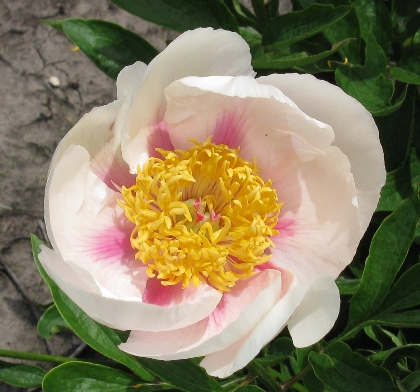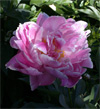|
|

|
Ann Cousins
|
|
Ann Cousins[Cousins, 1946]. Herbaceous, White, Double Blooms. It blooms Late Midseason. Flowers are large. Foliage is also large. Plant is a vigorous and healthy grower and a dependable bloomer. Full Double; very large, all white, fragrant. Very full petalled and the flower is of show table quality. Vigorous, productive, reliable opening among late sorts. However, medium tall stems will bend at the base; support is required to hold the bush together while in flower. Ann Cousins blooms 13 days after Red Charm. |

|
Anna Marie
|
|
Anna Marie[Seidl, 1984]. Tree, Pink, Single Blooms. It blooms Late. / Anna Marie is a very easy to grow Lutea hybrid. Flowers are a clear lavender-pink with dark basal flares and are single in form. It has no pollen, but will produce seed with some effort. Foliage is an outstanding deep blue-green coloration and cover all stems from view, as they hang down slightly. Plant form is very rounded and is quite desireable out of bloom. Plants grow quickly and are the easiest to graft of any of the tree peonies we have worked with. Stems and buds are extremely winter hardy and seldom experience die back, they are, however suseptible to wind damage. It will produce a large plant in 4 to 5 years. If wind does no break limbs off it has attained heights of 5 feet in Wisconsin. Anna Marie also produces many basal shoots that root after a couple of years and can subsequently be divided from the greater clump with ease. |

|
Antigone
|
|
Antigone[Daphnis]. Tree, Yellow, Single Blooms. It blooms Midseason. |

|
Archangel
|
|
Archangel[Saunders, 1950]. Herbaceous, White, Single Blooms. It is an Early bloomer. |

|
Arcturus
|
|
Arcturus[Auten, 1933]. Herbaceous, Red, Single Blooms. It blooms Late. Clear, rich red, fine form and substance. One of the early advances in red colored peonies. Single; clear, rich red, one of the early Auten advances in red colored peony flowers. Fine form and substance on a good plant. Medium tall, stiff stems. Pollen and seeds. |

|
Argentine
|
|
Argentine[Lemoine, 1924]. Herbaceous, Pink, Double Blooms. It blooms Late. |

|
Argonaut
|
|
Argonaut[Daphnis, 1996]. Tree, White, Semi-Double Blooms. It is an Early bloomer. Low growing, generally under 24 high. Stoloniferous and easy to divide |

|
Ariadne
|
|
Ariadne[Daphnis]. Tree, Pink, Semi-Double Blooms. It blooms Midseason. |

|
Astarte
|
|
Astarte[Saunders, 1951]. Herbaceous, Pink, Single Blooms. It is an Early bloomer. |

|
Athena
|
|
Details:
Apricot-buff petals with creamy lavender flares at center, an eye-catching color pattern, striking for garden, show table and in floral design. Light fragrance. The medium size, erect bush holds best against summer stress with shelter from summer wind and supplemental irrigation as needed. A Saunders Quads Hybrid, presumed triploid, but frequently has a few seeds, pollinate with a tetraploid. |

|
Athena
|
|
Athena[Saunders, 1949]. Herbaceous, Pink, Single Blooms. It is an Early bloomer. Apricot-buff petals with prominent lilac flares emanating from the center, a unique and eye catching color pattern, striking in floral design. Medium size bush, summer foliage appearance benefited by shade. According to the Peony Bloom Sequence Table, Athena blooms 9 days before Red Charm. |

|
Attar of Roses
|
|
Attar of Roses[Murawska, 1951]. Herbaceous, Pink, Double Blooms. It is an Early bloomer. Attar of Roses blooms 4 days after Red Charm. |

|
Auguste Dessert
|
|
Auguste Dessert[Dessert, 1920]. Herbaceous, Red, Double Blooms. It blooms Midseason.
Described in the 1928 APS list as big, round petals symmetrically graduated toward a loose center which shows a few stamens; silvery border; fragrance not notable. Plant of moderate height and seems fairly prolific.
Professor Saunders indicated that it is a very unusual shade of light red, a very solid color but not without some blue in it.
Thurlow said that Auguste Dessert's real petal color is violet-rose but the total effect lilac-rose. Fragrance unpleasant. Habit strong; tall stems. Fair as a cut flower but much better in the garden as its bold color makes an accent. |

|
Avra
|
|
Avra [Daphnis, 1995] |
|
|
|
|